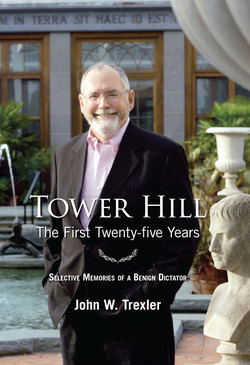Tower Hill

Реклама. ООО «ЛитРес», ИНН: 7719571260.
Оглавление
John W Trexler. Tower Hill
Foreword
Chapter One. California Story
Not Even Asking
Prejudice and Genocide
Propagation
Other Character Building Lessons
Sweet Peas
Chapter Two. Mosquitoes, Stock, Lilac, Magnolia, and Ancient Rome
A Lesson in Control
Gardening Badly
Building Rome
Busted
Chapter Three. Taking Root
Ginkgo Stinko
The Beacon Hill House
Finding a Direction
Gloria Gunnera
Sore Loser
High Anxiety
Master Planning
Chapter Four. Right Place, Right Time
An Eventful Evening
Apparently
Transactions
Public Garden Genesis
Bernice Heald
Politics
Martinis and Hot Buttered Rolls
Mend-a-Book
Dog and Pony Show
John and Frannie
Jade Plant
Chapter Five. From the Inside Out
Tower Hill Origin
The Tower Hill Mantra
Tax Exempt Status
Tornado
The Grand Duchess
Working Paper
Cary Award
Susan Dumaine
Decoupage, Décolletage, and Jews
The Old Barn
The Inferno
Our Pet Rock
Cleopatra
A Tray of Cookies
Wildlife Garden
Magnolia Tree
Chapter Six. A Garden of People
My Travels
A Lesson in Astronomy
Belvedere
Belvedere Bonus
Entry Garden and Entry Court
Orangerie
The Napkin
The Wilson Lemon
The First Gift
Camellias
Naming of the Lawn Garden
Chapter Seven. Honor Roll
Systematic Garden
Swedish Urn and Benches
Primordial Pool
Victorian Fountain Court
Kinship Arbor
The Vincenza Seasons
We Hold these Truths to be Self-Evident
Pliny’s Fountain
Pliny’s Path
Inner Park
Folly
Hercules Unchained and Wonder Woman
Henry’s Cupid
Temple of Peace
Frank’s Column
Trees
Oh So Personal—and Not
Wildlife Pond
Moss Steps
Chinese Gate
A Note on Phase III
Master Plan for Buildings
Finances
Sick as a Dog #1
Chapter Eight. A Garden Within Reach
Phase IV
Marillyn’s Piano
A Wonderful Connection
Sick as a Dog #2
The Loop Trail
Norman’s Rock
Barbara Booth
You never know where life will lead you … Or how I had a mild confrontation with Martha Stewart
The Last Acquisition
Interments
Newton’s Third Law
Conclusion. Festina Lente
Appendix
Ten Favorite Trees
Proposal for the New England Horticultural Center
From the Tower Hill Working Paper, January 14, 1987
Research
Education
Displays
Administration
Maintenance and Production
Visitors center
Preliminary Building Program - Visitors Center Phase One
Circulation
Parking
Awards and Prizes
Acknowledgments
Blood in the Veins
Отрывок из книги
In an age that worships creative disruption and entrepreneurial imagination, surprisingly little attention is given to the practice and virtues of reinvigorating venerable institutions. Sustaining older institutions and keeping them fit, relevant and forward-looking in a fast changing landscape offers social continuity and the communal benefit of prudent risk-taking and social change. Worcester, Massachusetts—New England’s second largest city—is something of an exemplar as a number of the city’s pre-eminent cultural and civic institutions, whose origins were in the nineteenth century, remain leaders in their respective fields today. Examples include the American Antiquarian Society (1812), the Children’s Friend (Worcester Children’s Friend Society 1849), the Ecotarium (Worcester Natural History Society 1884), the Worcester Historical Museum (Worcester Society of Antiquity 1875) and the Worcester Art Museum (1898). As progressive as each of these institutions has been and continues to be, it would be hard to match the transformational resilience of the Worcester County Horticultural Society (WCHS) which was founded in 1842—with roots in the Worcester Agricultural Society (1819). Relocated in 1986 from downtown Worcester to a magnificent site twelve miles away in the countryside of Boylston and officially retaining its original name, WCHS is now far better known as Tower Hill Botanic Garden. John Trexler, the animating spirit who led the transformation, has written an account that is fascinating in its own right, but which may inspire others to take a fresh look at the untapped vitality tucked away in older institutions.
Constructive institutional change is never easy. It takes vision, persuasiveness, support from diverse quarters, persistence and more than a little of what might be called romantic pragmatism. Above all it takes leadership, a “benign dictator” as John Trexler refers to himself in the title of this wonderful memoir. Horticulture can be ephemeral in the particular—a flower’s prime bloom is lovely but momentary—but when considered as a system, as a botanic garden, then horizons shift from weeks to decades and well beyond. Writing about gardens a century ago, Alice Morse Earle, a Worcester native and historian of early America, said, “Half the interest of a garden is the constant exercise of the imagination … to be content with the present and not striving about the future is fatal.” A lover of plants and gardens, John Trexler reveled in their presence from an early age, but his distinguishing gifts have been his ability to imagine the future and his vigilance in bringing that vision to life.
.....
Francis Lynde Stetson (1846-1920), legal consultant to J.P. Morgan, had pieced together Skylands from a collection of eighteenth century farms. His intention was to create a summer getaway from his Manhattan home. His landscape architect, Samuel Parsons, designed a comprehensive farm with an enormous barn and houses for staff dotted the 1,100 acres. Stetson’s impressive residence was built on a large level area at the foot of a hill called Mt. Defiance. A golf enthusiast, Stetson commissioned the design of a nine hole course adjacent to the mansion, interspersed with formal gardens and shrub plantings. A beautiful man-made pond acted as a water trap for the course. Parsons received an award from the American Society of Landscape Architects, an organization he helped to found, for the naturalistic design of the pond.
The overall effect of the estate was of great natural beauty. The property was accessible by miles of groomed dirt roads, and barns of varying sizes and pastures and fields accommodated cattle, horses, sheep, goats, ducks and chickens. There was even an abattoir for butchering. A carriage house and garage, and a pump house to provide water for the house, gardens, and golf course completed the complex.
.....